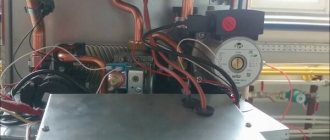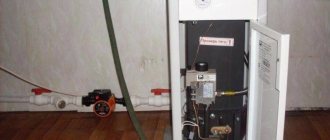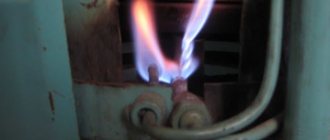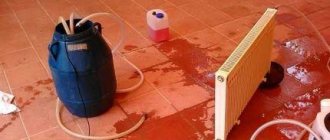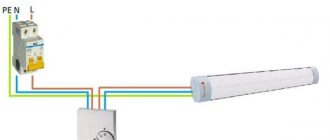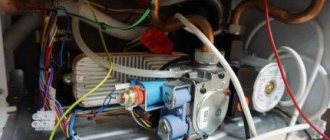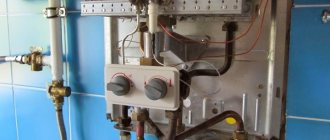Your Lemax gas boiler, which worked properly last season or even yesterday, does not turn on? Perhaps some problems arose before, but now it completely refuses to work? Agree, staying in the cold without heating in the house is not a bright prospect.
Most Lemax gas heating boilers have fairly simple, fully mechanical automation. This means that you can fix most problems yourself. This article will help you find and eliminate the reason why the boiler does not light up.
Let's consider both external factors that interfere with the operation of the unit and its internal breakdowns. We will provide instructions for actions in different situations, and also describe the features of electronically controlled boilers.
Marking
All versions of the line can be divided into 4 groups:
- AKGV
- KSGV
- AOGV
- KSG
This non-volatile equipment is capable of operating in closed and open heating systems. Coolant circulation - forced or natural. Next to the abbreviation - marking, there is a number indicating the power - 7-35 kW. The marking also indicates the type of automation:
- T or AT – SABC AT;
- C – SABC S RD;
- E or EM – Eurosit.
Almost all modifications are made in accordance with current trends in minimalism. There is a pressure gauge in front, and other automatic elements are hidden in the housing. A distinctive feature of the products from “ServisGaz” is their white color. The radiator is made of steel, the burners are made of heat-resistant stainless steel. Equipped with a condensate collection device.
Why is blood pressure rising?
Increased pressure is a serious and dangerous situation. An increase in pressure in the system can only mean an increase in the amount of water.
This occurs due to the expansion of the coolant when heated. Any liquid is incompressible, so an increase in its volume can lead to rupture of the heat exchanger, or, in the most serious case, provoke an explosion.
To eliminate this possibility, an expansion tank is used in the design of boilers. It absorbs excess water volume, compensating for its increase when heated.
An increase in pressure most often indicates a problem with the expansion tank. Its design consists of a container and an elastic membrane installed approximately in the middle.
When the liquid begins to flow, the membrane sag and makes room for excess water.
When the volume decreases, it returns to its previous position. If the membrane is torn or not firmly attached to the expansion tank stacks, the coolant will fill the entire volume of the tank.
When expanding, the water will have nowhere to go, which will provoke a constant increase in pressure. The solution to the problem is to restore the condition of the membrane or replace the expansion tank with another, serviceable copy.
Why does the device go out?
There may be several reasons for the burner to go out:
- Stopping the gas supply. Turn off the boiler and wait until the supply is restored.
- Unstable or absent voltage in the power supply network (for volatile Lemax boilers).
- Failure or activation of the traction sensor. We need to check whether it is there and whether the chimney is clogged. Sometimes cleaning the sensor contacts helps.
- The thermocouple contacts have oxidized and do not close. It should be cleaned with fine-grained sandpaper.
- Reverse, insufficient or excessive draft. The draft sensor responds to all situations by turning off the burner.
Problems with traction are most common in non-volatile installations, where the stability of the unit’s operation depends on it.
If the draft is too weak, the sensor turns off the burner due to the possibility of smoke in the room.
Excessive draft is dangerous due to the possibility of the flame on the burner exploding, which will provoke the supply of gas into the room with unpredictable consequences. Therefore, an increase in draft against the set value is also an emergency event, leading to the boiler stopping.
Clogged igniter and burner nozzles
Natural gas, which runs in household pipelines, is not a 100% pure substance - it contains additives and impurities. Some of them are added intentionally (for example, to create a specific “gas smell”), others are formed as a result of careless cleaning.
And the gas itself (a mixture of methane and in small quantities - propane, butane and ethane) does not burn without a residue - hours of operation of the burner generate soot and soot, which gradually settles on the boiler parts and can lead to clogging and clogging of thin channels and holes - jets , through which gas is supplied to the igniter and the burner itself.
An atmospheric boiler igniter is a special device that allows a small flame to burn. When the gas supply is turned on cyclically, it is the gas that ignites the mixture supplied from the burner. A constantly burning “wick” smokes even more than a burner, since the pressure in the igniter is low. If soot clogs the pilot nozzle, the boiler will not be able to turn on the next time.
Burner nozzles become clogged much less frequently, since gas is supplied there under pressure in large portions, but this situation cannot be completely excluded.
Expert opinion Filimonov Sergey Vinokurovich Heating equipment repairman
If you decide to clean the jets yourself, be careful. The fact is that the nozzle channels are made of relatively soft metals - copper or brass
Using steel wire or a brush can damage the equipment. Use copper wire or a brass brush.
Electric boilers
A fairly common alternative to gas and solid fuel boilers. Lots of advantages, high efficiency, but long payback period. The connection is simple, like with gas boilers, but without a cold water supply. Temperature regulation and overheat protection are provided.
Mechanical boiler timer
Using a simple mechanical timer for an electric boiler, there are three options for starting the central heating system:
- The boiler is turned off;
- The boiler supplies warm water;
- The boiler turns on and off at the set time.
Mechanical timers usually have a large round dial with a 24-hour scale in the center. By turning the dial, you can set the desired time, and then leave it in that position. The boiler will turn on at the right time. The outer part consists of a set of tabs for a 15-minute period, which are inserted for easy adjustment of operation and mode settings. Emergency reconfiguration is possible, which is performed with the boiler connected to the network.
Mechanical timers are easy to set up, but the boiler always turns on and off at the same time every day, and this may not satisfy the owners if the family is large and bathing procedures are carried out several times a day at different times.
Power outages
It happens that the voltage in the electrical network drops below the permissible level. In this case, the boiler immediately goes out, since modern automation can detect low voltage. When the power supply is restored, the same automation will turn on the burner, so most of these failures can go unnoticed. However, this mode of operation is harmful to electronics, so they may fail over time. So if suddenly the gas does not light up when voltage appears in the network, something may have happened to the automation. To avoid such a scenario, it is better to buy a voltage stabilizer.
How to distinguish the norm from the problem?
If your boiler turns off briefly from time to time while working, this is a normal phenomenon; this is how an automatic system works, protecting the equipment from overheating and you from overpaying for bills for housing and communal services. The heat exchanger heats up periodically, heating the water to the set temperature.
But in the case when the boiler, after working for several minutes, immediately turns off without completing its direct task of heating, this indicates a malfunction. This is called a short cycle, which is dangerous not only due to insufficient heating of the room, but also large gas bills, and in the long term this malfunction will lead to serious damage to the boiler, which will require expensive repairs or even its complete replacement.
This is why it is important to take appropriate action as soon as you notice that the boiler has started to short cycle
What is short cycle mode?
When your heating system doesn't need to be turned on, the heated water in the heat exchanger will naturally cool as heat escapes through the flue and around the boiler body itself.
The boiler has its own internal thermostat. When the boiler cycles briefly, this internal thermostat detects that the water in the heat exchanger is cooling and, although the temperature in your home has not dropped, starts the boiler to heat the water again. It doesn't take long for the heat exchanger to heat this small amount of water back up to the thermostat temperature, so the boiler quickly turns off again.
If the boiler is burning every few minutes, it is using gas but not heating your home. This wastes fuel which will increase your heating bills and carbon emissions, which in turn can cause damage to the heat exchanger as it is overworked.
If a heat exchanger malfunctions, it usually costs more than thirty thousand rubles (depending on the boiler model) without taking into account the labor costs of a gas safety engineer. Therefore, it is much more advisable to take appropriate measures before a major breakdown occurs at a time when replacing a faulty part does not become an expensive and time-consuming process.
Problems with closed-type turbocharged equipment
If you have installed a new chimneyless appliance, but the fireplace in it periodically goes out, it is worth checking the components and parts. The problem can be identified by the following symptoms:
- When the igniter is lit, it periodically goes out. This indicates a malfunction of the thermocouple, which affects the operation of the gas valve. The thermocouple is made in the form of a copper tube. At the end there is a bimetallic part. When different metals come into contact, a voltage of 20-50 MW builds up, which keeps the gas valve open. If the thermocouple breaks down, it cannot be repaired and must be replaced.
- Floor-standing unit “Hephaestus”, “AOGV”, etc. doesn't light up at all. Check the automation and wiring from the traction sensor to the automatic unit.
- Ignition occurs with popping noises, a yellow flame bursts out - this is a clogged jet. They can become clogged with soot, dust, and dirt. You can clean them yourself if you understand gas equipment.
- Circulation pump malfunction. In this case, the fire will go out, or ignition will not happen at all. The unit is being diagnosed and replaced.
- The traction sensor is broken or clogged. This flat element is connected to the fuel valve. Close the leading contacts and light the burner. If a fire occurs, then the sensor needs to be replaced. When oxidized, the contacts are cleaned with fine sandpaper.
Typical problems with turbo boilers
The problems described above also occur with turbocharged boilers. But in addition, given that boilers with a closed combustion chamber are equipped with additional elements, additional “troubles” can happen to them.
For example, during their operation you may encounter the following difficulties:
- icing of the coaxial chimney outside the house;
- failure of the built-in air blower.
Their design, of course, is more complex than that of models with an open combustion chamber. But at the same time, you can carry out all the same manipulations with them as with atmospheric boilers.
Condensation accumulation and icing are also common causes of boiler failure. This happens if during installation the standard slope was not observed to ensure the drainage of condensation moisture
But let us dwell in more detail on the breakdowns characteristic of this type of equipment.
Icing of the hood or chimney
If you observe that the boiler goes out most often in frosty conditions, then most likely the chimney opening is blocked by an ice mass.
This may happen due to:
- formation and accumulation of condensate;
- snow accumulation.
As you can see, the reason is bad weather conditions. Therefore, the solution to the problem is to protect the chimney from external factors.
In this case, again, it is worth considering the option of installing a “fungus”, i.e. deflector. But this is a preventative measure. But what to do if the problem has already “ripened”, and weather conditions further aggravate the situation? There is a way out in this situation too.
You can “melt” the chimney, that is, rid it of ice plugs, yourself using a hair dryer or a gas burner on a spray can
Condensate settling in pipes is typical for convection boilers with a coaxial chimney. Plugs form in them due to the difference in temperature of the air flows drawn into the burner from the street and coming out. These ice jams block the path both into and out of the combustion chamber.
To remove the ice crust from a coaxial chimney, you may even need to dismantle its outer part. Dismantling will not affect the daily operation of the system, but it is still better not to let it happen. Sometimes, in order to prevent the accumulation of condensate in the gap between the pipes, a pair of holes are drilled in the outer contour.
Simply breaking the ice is not the solution. Moreover, the chimney may be damaged. It is better to buy a portable gas burner with a can and “melt” the chimney with it. After the plug melts, the boiler will start working again. But to prevent such incidents from arising in the future, the pipes should be insulated.
The second prerequisite arises in cases of installation of eaves caps: they protect the chimney from precipitation, but in winter they cause more trouble than they are worth, impeding the outflow of flue gases.
Fan or turbine malfunction
When the wick of a gas boiler with a built-in supercharger suddenly goes out during operation or does not initially light up, listen to the sounds it makes.
During normal operation, the turbocharging system should hum steadily, so you should be wary of the appearance of extraneous noise.
Turbocharging, applied to the design of boilers with a closed combustion chamber, in most cases cannot be repaired - it is easier to replace it immediately
If there are none during operation, the breakdown is obvious: that is, the automation does not allow the safety valve to open, so the wick does not light up.
In this case, we strongly recommend not to engage in amateur activities, but to immediately call the gas workers. In most cases, turbocharging cannot be repaired - most likely it will have to be replaced, and such work is associated with the risk of carbon monoxide spreading throughout the room.
Therefore, it is better if this process is monitored by a gas engineer from a company with which an agreement has been concluded for equipment maintenance and gas supply.
Gas burner goes out
It is also possible that gas and electricity in the AOGV (Gas Water Heating Unit) are available in the required volume, but the burner constantly goes out. The equipment turns on, works, and then the flame in the firebox goes out. Here the problem may lie in the draft or the thermocouple that controls the presence of fire. It is possible that there is either a lack of air for combustion or a breakdown of the internal elements of the boiler.
The first option is a malfunction of the traction sensor or its absence in principle. To check whether there is an air flow into the firebox, just hold a burning match to the inspection window of the gas boiler. The flame should deviate towards the firebox. If it is motionless, then there is no traction.
In this case, first you need to open the windows and door slightly so that the air enters the furnace room. If this does not help, then you will have to clean the boiler and chimney. The cause of the problems lies in them, or more precisely in the accumulations of soot on the walls of the pipe and firebox.
The second option is a thermocouple. The contacts of this sensor may simply come off. As a result, the relay that shuts off the nozzles constantly receives signals that the fire has been extinguished. Fuel should not flow into the combustion chamber; the solenoid valve shuts off its supply. It is necessary to check the connection of this device to the damper. The connector should be free of oxides and dirt. If there are any, you will have to clean them with fine sandpaper.
Boiler attenuation due to reasons within the system and their elimination
The most common reason for a boiler to go out is a lack of oxygen to the burner. This malfunction is inherent in economy class models, which are purchased more often than others. Expensive boilers have a special exhaust device that multiplies the air flow, maintaining combustion in all weather and internal conditions.
Lack of oxygen is a common cause of soot and gas burner extinguishing. The fire goes out because the missing air flows are captured from all the holes, the flame moves, the temperature of the thermocouple drops and the protection turns off the burner as if the temperature had reached the maximum value. Other reasons for the boiler burner to go out:
- In gas boilers with a turbocharger, a built-in electric fan helps pump air. If it does not work correctly, the burner may also go out. It's easy to diagnose a fan - when it's off, it continues to make noise.
- A non-functioning draft sensor is another reason for the boiler to fade. It should turn on if the temperature in the smoke catcher rises from hot steam, which for some reason did not enter the chimney.
- The burner does not ignite or burns poorly - the nozzles are clogged. Clean them with a brush or wire of the appropriate diameter.
- If air enters the boiler gas pipeline, the boiler operation is blocked and an error appears on the display. The reason why a gas boiler goes out can be easily eliminated - you need to start the boiler again, first unlocking it according to the instructions.
- During operation of the boiler, the gap in the igniter may be damaged or contact with the wire may be broken, or the air filter on the air line may become clogged. It is almost impossible to restore the gap with your own hands - you need the help of a gas specialist. But you can clean the filter and check the reliability of the connection of the current-carrying conductor yourself.
- The gas burner may not go out immediately, but after several minutes. The reason most often lies in contamination of the ionization electrode. Also, the correct gap in the electrode could be broken, or the connecting wire could fall off due to constant heating.
- The flame breaks away from the burner and goes out. Usually, the injector begins to make noise and whistle. The malfunction is eliminated by adjusting the gas pressure on the ignition electrode. The flame can break off if the draft is very strong - this phenomenon occurs with strong supply and exhaust ventilation.
- If the boiler is installed in a private house, then the flame may die out if the chimney pipe is installed very high.
- Spontaneous shutdown of the boiler, accompanied by strong noise, occurs due to a non-working pump or fan (explained above). A non-working thermostat causes the water to boil, followed by the flame breaking off.
If the voltage in the network fluctuates and decreases, the boiler burner may go out - the automation is activated, which recognizes the low voltage. After the power is restored to normal, the protection turns the boiler back on, so most of these cases go unnoticed. However, unstable voltage has a negative impact on the operation of electronic protection systems.
And a very obvious reason for the burner to go out is low gas pressure in the line. This trouble can happen not only due to breakdowns in the external gas pipeline, but also due to internal problems.
- There is a malfunction in the gas meter. Check visually whether the mechanism is working and whether the numbers on the display are jumping. Even if this is the case, the malfunction may be delayed - and the meter is often noisy.
- Gas workers require the installation of monitoring equipment - gas leakage sensors and temperature sensors. They monitor compliance with the regimes around the boiler. When the sensors are triggered, the boiler turns off.
- The connections in the gas pipeline are leaky. A gas leak means low pressure, so the automation reacts immediately and the boiler turns off. If there is no leak sensor, then this type of malfunction is determined by the smell of gas. To identify the malfunction and eliminate it, check the joints on the line by applying soap foam - if there is a leak, the foam will bubble.
Automation of boilers - the wick goes out after releasing the button
There is also a decrease in gas pressure in the inlet pipeline. Sometimes there is a lack of voltage on the control board. Remind us what service work needs to be performed in case of conversion from methane to propane? First, you need to change the nozzles of the main burner of the GGU. Then change the supply voltage of the modulator.
And at the end, adjust the parameters of the highest and lowest pressure. What principle of operation does the safety valve have in a heating system? This component, which is adjusted to the required pressure, protects the heating system. It is prohibited to use a safety valve to drain heating water. The heating system pressure often rises. In the expansion tank we lower the pressure to 2.
Can heating circuit water leak from the DHW system? The increase in pressure in the heating system is formed by the following main factors. The pressure for the expansion tank is not adjusted.
The make-up tap is leaking.
Main reasons: why the gas boiler goes out
Starting up is difficult. The igniter lights, but the main burner has no fire. Please tell me what is the reason? Apparently, the ignition unit is faulty. You will need to do a technical inspection of the unit and clean the ignition mechanism. Can anyone help clarify the situation with the chimney pipe? Soon it will be three days before a return draft arises, due to which the smoke passes directly into the room. I made the chimney myself.
It is a steel pipe. There may be a discrepancy in the calculations. The main reason is an incorrectly manufactured chimney pipe design. Soot contamination often occurs, which significantly reduces its efficiency.
In addition, it is necessary to check the exhaust openings in residential areas. Heating system control. Transfer to another type of gas.
Adjustment devices and protection devices. After starting, a malfunction appeared. It doesn’t want to turn on, it worked for two years, now the whole display lights up, just like when the boiler is turned on, when the self-diagnosis mode is in progress, then it clicks, turns off for miles and seconds and turns on the whole display again. It turned on once, but it gives the error E10 water pressure, although the pressure in the system is 1. Tell me, what could be wrong? In operation, the Baxi main four boiler turns off with error E35 stray flame. Tell me what to do?
First season in operation. We installed and connected the Baxi Fourtech 24 F boiler. What cold water pressure is allowed at the inlet to the DHW device? Bosch boiler 24 kW, single-circuit with built-in three-way valve. The boiler sensor does not see it and gives an error.
Tell me how to do it so that it doesn’t give an error and works normally for both the heating and the boiler?
Question: Lemax floor-standing boiler, with two buttons, red and white. It stopped starting automatically, the wick is burning, but it starts when you turn the gas regulator to zero, and then raise the temperature and the boiler lights up, please kind people tell me what the problem could be, otherwise we freeze at night. Answer: the rod is jammed in the middle part of the automation. Question: my Lemax KSGD boiler with a GTU 24D burner goes out when there is wind on the igniter. Answer: it is necessary to increase the gas supply to the pilot burner; most likely, when the main burner is turned on, the flame on the pilot burner decreases, which leads to the activation of the automatic protection.
If you turn off the DHW flow sensor, maybe it will be possible to reprogram it into a single-circuit device through menu L3? We installed an Arderia esr 2 boiler. If my coolant pressure drops a little over the course of a day by a couple of notches, could the reason be a faulty three-way valve? Are there no leaks from the radiators?
The gas boiler Arderia 2 is in operation.
Solving problems with boiler attenuation
If the flame goes out not due to malfunctions of the boiler itself, but to other external reasons, you can try to fix the problems yourself. Some models of simple boilers can even be cleaned from soot and soot yourself, but this is a topic for a separate article.
Restoring traction
You can figure out what is clogged - the boiler or the chimney - by disconnecting the corrugated pipe of the exhaust system from the boiler itself. If there is draft in the pipe, then we solve the problem with the boiler by calling a technician. Otherwise, you will have to climb on the roof and look into the pipe. If a blockage is detected, you need to remove those foreign fragments that interfere with the passage of smoke.
Cleaning the chimney is a mandatory procedure to prevent its contamination
If ice is found on the head, it must be carefully chipped off so as not to damage the chimney itself. Be sure to check the cleaning hatches. A sign that cleaning needs to be done is a large amount of soot and soot extracted from the inside of the channel.
You can still reconcile with the blowing of the channel due to strong wind if it happens once or twice during the entire heating season. But if winds are a common occurrence in your area, you should take measures:
- First, you can try to extend the pipe. The high altitude will prevent the wind from pushing the air back with force.
- Secondly, a competent configuration of the head can help out, which will cover the hole on the side from which the winds predominantly blow.
If the electricity goes out
A non-volatile boiler in conjunction with a circulation pump does not consume much. It can be adapted for DC power and switched to battery operation. But this is not suitable for powerful boilers. The only way out is to connect the boiler to an alternative source of electricity, for example, a gasoline or diesel generator.
If the gas pressure decreases
The first thing you need to do is check the gas pipeline at the place where it branches off from the main line. The joints where there are traces of welding, as well as valves and taps, are carefully checked. The specific odor imparted to natural gas at distribution stations will help detect leaks.
The only option is to write an appeal to the appropriate authorities. Contact your neighbors - they most likely have the same problem. Completing a collective petition will help speed up the decision-making process for the natural gas supplier organization in your area.
Let's get started
To determine the cause of the malfunction, we will check the thermocouple circuit - solenoid valve. First, let's check the traction sensor. In this boiler it is located on the gas duct. To do this, remove two terminals from the sensor.
We close the two terminals together; they should connect tightly (to do this, you can press them a little with pliers).
We are trying to ignite the igniter. If this was possible, the cause of the malfunction is in the traction sensor. However, do not rush to change it. Let's check it first.
Note: in this work we dismantle the sensor in order to show the features of its installation on the boiler and the markings. This is not necessary for verification.
Unscrew the two screws securing the draft sensor to the boiler flue.
Please note that the sensor is not attached tightly to the flue body, but is mounted on paronite gaskets. This is necessary in order to reduce the heating of the sensor through its contact with the body, and also to ensure a gap between the hole in the flue duct and the plane of the sensor.
We inspect the sensor. Its contacts must be firmly attached to the body. There should be no oxidation on them. The sensor rating (the temperature at which the sensor contact opens) in this case is 75 °C (designation on the housing L75C).
We check the traction sensor with a tester, measuring its resistance. It should be minimal (equal to the resistance of the probes) - 1–2 Ohms. If the sensor does not ring, it is clearly necessary to replace it with a similar one (with the appropriate response temperature).
If the sensor was able to ring, wipe the contacts of the sensor and the circuit terminals with alcohol, tighten them with pliers and dry them. We mount the sensor in place and connect it. We are trying to ignite.
If ignition was successful, the cause of the malfunction has been found and eliminated.
Be sure to check the draft after igniting the main burner. To do this, you can bring your hand to the place where the traction sensor is installed. No heat should come out of this hole. If this happens, it is necessary to eliminate the cause causing insufficient traction. In this case, the sensor works correctly.
Attention! Operating a boiler with a faulty chimney is strictly prohibited!
If ignition fails, we move further along the chain. The contacts from the draft sensor go to the draft breaker (thermocouple breaker).
We remove the terminals from the contacts of the traction breaker and measure the resistance of the circuit. It should be no more than 3 ohms.
If this condition is met, we perform the following actions. Using wrench No. 9, unscrew the nut securing the thermocouple to the traction breaker. Using wrench No. 12, unscrew the traction breaker, which consists of two parts: a brass sleeve and a plastic insert, by half a turn.
Connecting a room thermostat
A room thermostat is a convenient and useful device that allows you to regulate the temperature of the air, not the coolant, in the heating system. The default sensor monitors the outlet temperature of the heating agent.
This does not give a correct picture of the state of the microclimate in the room. For example, when the outside temperature rises, the room becomes hot.
But the sensor cannot track this, and the extract air temperature is within the limits specified by the mode, so from the point of view of the system, everything goes fine, in accordance with the boiler settings.
If a room thermostat is used, the burner will turn off much earlier, which will improve the microclimate in the room and significantly reduce gas consumption.
To connect the room thermostat, you need to set the boiler's own element to the maximum temperature.
It will only work as a limiter when overheating. The external unit is connected at one end to the automation unit, and at the other to the boiler thermostat. By default, a jumper is installed between the contacts, which must be removed and the thermostat connected.
IMPORTANT!
It is necessary to use the appropriate brands, for example - CEWAL RQ10. Installation of a thermostat is only possible on boilers marked N (with the SIT 820 NOVA automation unit).
Heat loss does not correspond to boiler power
Constant operation of the boiler may be due to insufficient power of the device. The coolant, having passed through the pipes, returns, and by this time, the water has not had time to heat up due to insufficient power. Therefore, the gas boiler does not turn off. The boiler power is selected based on a number of key parameters:
- area of heated premises and number of storeys of the building;
- climate features of the region;
- the materials from which the house is built, the quality of thermal insulation materials, the quality of seam sealing, window insulation, the number of chambers of window profiles, etc.
- the number and volume of all heating devices and pipe circuits installed in the system, additional buffer tanks, separators;
- temperature level that needs to be maintained.
It is best to entrust the calculation of boiler power to a professional or use special formulas or online calculators that allow you to determine the main characteristics of the boiler as accurately as possible, taking into account all parameters.
Often, a simple formula is used to calculate power, which is defined as 1 kilowatt of power per 10 square meters. m of heated room. In this case, several correction factors are used, taking into account climatic conditions, the degree of thermal insulation of the house and other parameters
In addition to choosing the boiler itself, it is important to correctly select the remaining components of the system, pipes with the appropriate cross-section to ensure the required throughput
Gas boiler clocking: causes and ways to eliminate them
The term “clocking” refers to the frequent switching on and instant shutdown of a boiler, which in fact does not fulfill the main task of gas equipment to heat the coolant. Such a “symptom,” if not eliminated, will provoke serious breakdowns, followed by expensive repairs.
Why is this happening?
So, you approached the boiler and noticed that it starts working as expected (the torch fires), literally a few seconds pass and it immediately turns off. A few seconds later the situation repeats itself.
The first and most harmless problem from a maintenance point of view is incorrectly installed power when the heating system is short. Let's look at an example: your boiler is set at 55℃, and the pump is set to maximum values.
In a closed system there are only 2 radiators, and outside the window the temperature is above zero. What we have: the return flow pumped from the system returns to the heat exchanger, where, due to the temperature difference, the torch must automatically fire and the boiler ignite in order to eliminate this difference by heating.
Expert opinion Vadim Savelievich Grebnev Heating systems installer
In practice, the return flow has not had time to cool down, so the boiler actually has nothing to heat, which causes it to turn off automatically. The next time it will turn on in about 1-2 minutes, since the heating circle is small. The situation will repeat itself.
Also, the problem of frequent turning on and instantaneous shutdown can be caused by the following reasons:
- Insufficient gas pressure in the system - the boiler automatically goes out because the required volume of gas is not released at the set power.
- Pump malfunction - the unit either does not pump water at all, or pumps it so quickly that it does not have time to go through all the stages from heating to transferring heat to the batteries.
- Overheating of the boiler itself - the manufacturer has established recommended limits for the safe operation of the boiler. If the temperature is higher than normal, an emergency shutdown may occur. This will happen exactly until the boiler cools down.
- Malfunctions of the thermostat - this device can fail due to sudden changes in the voltage in the network, which leads to distortion of the received data and the sending of a false signal to the central board about the need for a quick shutdown.
What to do?
The first thing to do is to correctly set the power of the boiler and pump. If these are the minimum values, then it is enough to set the pump to medium speed. When the water heating is more than 45℃, you can increase the speed.
It is important to set the power correctly
The sequence of actions is as follows:
- Turn off the boiler completely and give it 10-20 minutes to cool down.
- Light it using the lowest temperatures.
- Adjust the pump operation.
- Evaluate the result.
If the problem recurs, but not as often, the thermostat will save you. This device monitors the return temperature and forcibly starts the boiler only if its temperature is lower than the manually set one. The thermostat is good in all respects: it saves gas, protects the boiler, and the pump does not overheat.
Expert opinion Vadim Savelievich Grebnev Heating systems installer
The rest of the work to check the gas pressure level in the system and the serviceability of the thermostat with the pump is carried out only by a specialist. All you have to do is contact the service department, whose technicians will quickly find the problem and fix it before it causes a serious breakdown.
How to turn on, light up
To heat water, you need to wait until the required volume is completely filled into the system (on average 12 liters per kW). After connecting the pipeline, the procedure will be as follows:
- remove the cover to see the regulator and piezo ignition;
- turn the regulator counterclockwise to turn on the device;
- press all the way and lock the regulator, at the same time press the piezo ignition;
- a light should appear on the ignition burner (after this, release the piezo ignition and hold the regulator for another minute).
If you fail to connect the equipment, do not rush to try again immediately. Wait a couple of minutes.
How the Lemax boiler works and how it works
The location of Lemax's enterprises is the Russian city of Taganrog. The supply of main components for boiler equipment assembled at our own facilities is carried out by both Western and domestic partners. The production of the heat exchanger and housing is mainly carried out by Russian enterprises, while control units, automation and burners come from abroad.
Boilers of this type can be equipped with both open and closed combustion chambers. There are always pressure and temperature regulators on the body of the units. As a rule, you can turn on a Lemax boiler not only from the mains: some models do not depend on electrical energy at all. According to safety regulations, a Lemax device must always be connected to a chimney. Only rooms with good ventilation are suitable for installing the equipment.
A characteristic feature of Taganrog devices is the simplicity of the procedure for lighting a Lemax boiler. Regardless of how many circuits this equipment serves, and what kind of material was used for its manufacture, connecting it to the electrical network usually does not cause any particular difficulties. A prerequisite is the use in the circuit of how to turn on a Lemax gas boiler, a voltage stabilizer (any surge can cause a breakdown of the device).
The Lemax boiler consists of the following components:
- Gas burner.
- valves.
- Control boards.
- Expansion tank.
- Circulation pump.
Equipment of this type operates mainly on gas, where the heat exchanger is heated due to the operating burner. The design also includes a coil designed to supply hot water. Both natural and forced methods can be used to circulate coolant in the circuit.
Availability of automation
The automation of the Lemax gas boiler sometimes significantly expands the scope of use of the device. Above is a list of some characteristics that should be followed when choosing gas heating equipment. Knowing them, you will be able to independently determine the modification of the unit, which is the highest priority. Initially, you have to determine the heat loss of the building, and only then calculate the power of the boiler.
Sources
- https://teploclass.ru/kotly/gazovye/gazovyj-kotel-lemaks
- https://www.stroy-podskazka.ru/otoplenie/kotly/lemaks/
- https://utepleniedoma.com/otoplenie/otoplenie-doma/kotly-lemaks
- https://teplospec.com/gazovoe-otoplenie/kak-vklyuchit-kotel-lemaks-pravila-ekspluatatsii.html
- https://fb.ru/article/229439/gazovyie-kotlyi-lemaks-otzyivyi-i-instruktsiya
What models are there?
The main types of Lemax gas boilers are:
- Floor-standing models with steel or cast iron heat exchanger.
- Wall mounted solid fuel.
The solid fuel type of equipment is represented by two models:
- Wood stoves.
- Coal boilers.
Wall-mounted boilers are produced only as double-circuit boilers: they are capable of operating at pressures up to 3 bar. In all cases, Italian automation and circulation pumps are used. Wall-mounted models include a 6-liter expansion tank. This equipment is guaranteed for 2 years. Floor-mounted modifications equipped with steel heat exchangers are also in high demand. For their manufacture, high-strength metal with a thickness of 2 mm is used.
There are 5 models of steel boilers with different capacities:
- Lemax premium.
- Premium nova.
- Gazovik.
- Clever.
- Patriot.
The Premium nova model is considered the most advanced today. Thanks to automatic settings, the device can independently both start a Lemax gas boiler and set optimal operating parameters in the system. The Patriot series devices are characterized by the presence of a closed combustion chamber. They are produced exclusively as single-circuit ones, without the need for electrical power and a chimney. The presence of a 4 mm thick cast iron heat exchanger for the Leader and Wise units extends the service life by approximately 2 years. They are not afraid of various contaminants and the effects of corrosion.
The pump is not working well
Users of gas boilers sometimes encounter various problems with the operation of the pumping unit. Such equipment stops pumping water if the rotor fails or a significant amount of air has accumulated in the internal part. To prevent such a breakdown, it is necessary to unscrew the nut from the unit and drain the water, after which the axle is forced to rotate using a flat screwdriver.
Pump in a gas boiler
Free-standing equipment requires compliance with installation rules. It is advisable to install the pump before the gas boiler, which will extend the life of the heating system. This rule is due to the presence of high temperature conditions at the boiler outlet, which can cause damage to the device. Of course, the design characteristics of the circulation pump must also be taken into account, as well as the need to mount a filter or sump directly in front of the pump.
The principle of operation of the thermostat in a gas boiler
Essentially, a thermostat is a temperature sensor that provides a signal to the system. Thanks to it, thermal energy is generated to the desired temperature. With the help of this part of complex gas equipment, the temperature in the building is constantly maintained at a certain level and the boiler is turned on and off when the required values are reached.
Thermostats are of the following types: electronic and mechanical. Mechanical types allow you to adjust their operation using a knob. The electronic version of the thermostat is started electronically, and sometimes has a remote control.
Such thermostats are very convenient and help to significantly save money on heating. Thanks to this part of the gas boiler, when the room temperature rises, the system reduces the frequency of switching on, which significantly saves gas consumption. Also, the ambient temperature can affect the switching on of gas equipment. This is especially noticeable in the spring.
Reasons for clocking
Clocking indicates the frequency of switching on of the device that provides heating of the thermal fluid. In the absence of external control devices connected to the equipment, most often the time interval between turning on the boiler does not exceed 10 minutes, and by default such indicators are only three minutes. Frequent switching on and off is not a recommended mode for operating a gas boiler.
In order to maximize the economical consumption of blue fuel, it is advisable to choose the option of continuous operation of equipment with compensation for heat losses. Among the main problems that provoke the clocking of the unit, the following can be noted:
- overheating of the device under high power conditions;
- insufficient gas supply pressure;
- incorrect installation of the thermostat;
- various pump breakdowns;
- filter clogging.
In small rooms, excessive gas consumption is common, so when choosing equipment it is very important to correctly calculate its technical indicators and basic operational characteristics. Among other things, the configuration parameters of different models often differ significantly, which requires a mandatory and very careful study of the instructions before configuring the equipment
Let's look at the main reasons for the boiler constantly turning on and off.
